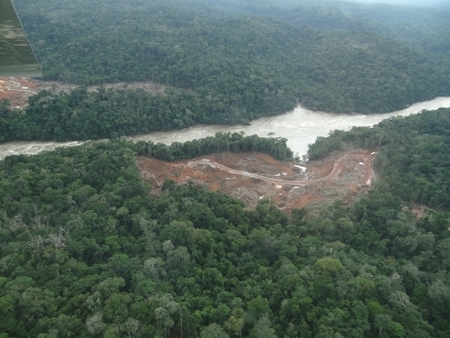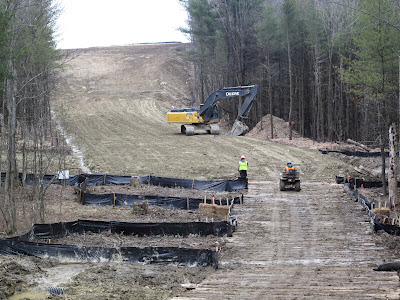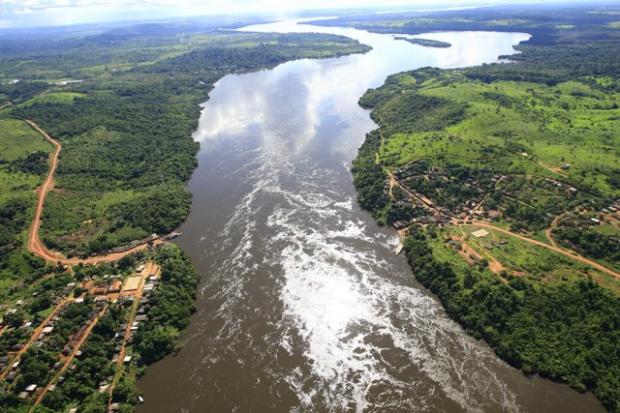by Deep Green Resistance News Service | Aug 28, 2012 | Colonialism & Conquest, Indigenous Autonomy
By Agence France-Presse
Brazil’s Supreme Court has approved the resumption of work on the huge Belo Monte dam in the Amazon, which was halted earlier this month after protests from indigenous groups.
The preliminary ruling on Monday overturns an earlier ruling that ordered construction of the dam across the Xingu River, a tributary of the Amazon, to be stopped until indigenous peoples can testify before Congress.
However, the decision by Supreme Court President Carlos Ayres Britto could be revised when the court examines the case further, its website said.
The dam, expected to produce 11,000 megawatts of electricity, would be the third-biggest in the world, after China’s Three Gorges facility and Brazil’s Itaipu dam in the south.
A regional federal court, in the earlier ruling, had noted that when Congress approved the project in 2005, it called for an environmental impact study after the start of the work.
By law, the native communities had the right to air their views in Congress on the basis of the study, but this was not done, the court said.
Work on the dam began a year ago, despite fierce opposition from local residents and green activists.
Indigenous groups fear the dam will harm their way of life while environmentalists have warned of deforestation, greenhouse gas emissions and irreparable damage to the ecosystem.
“Avatar” director James Cameron and actress Sigourney Weaver have given their backing to dam opponents, drawing parallels with the natives-versus-exploiters storyline of their blockbuster Hollywood movie.
Belo Monte is expected to flood an area of 500 square kilometers (200 square miles) along the Xingu, and displace 16,000 people, according to the government. Some NGOs estimate that 40,000 people would be displaced.
From Yahoo! News:

by Deep Green Resistance News Service | Aug 26, 2012 | Biodiversity & Habitat Destruction, Colonialism & Conquest, Indigenous Autonomy, Lobbying
By Fabiola Ortiz / Inter Press Service
The Sete Quedas or “seven waterfalls” on the Teles Pires River, which runs through the Amazon rainforest states of Mato Grosso and Pará in central Brazil, are a spiritual oasis venerated by several indigenous groups.
But the 20-metre-high rocky falls are to be covered by a reservoir created by a hydroelectric dam that is to flood an area of 95 square km.
“It’s a sacred area, our creator and mother. And the ‘pajé’ (shaman) says it is where the fish lay their eggs,” João Kayabi, 52, told IPS by phone from the area. He is the chief of Kururuzinho village, home to 106 members of the Kayabi community, who speak a Tupí-Guaraní language.
For the Kayabi, the area around Sete Quedas must be left untouched, because it is the dwelling of a god who is responsible for the natural balance.
“It will be left underwater, and will only be a memory. We are trying to keep that from happening,” Kayabi said.
Sete Quedas is also sacred to two other indigenous communities: the Apiaká and the Mundurukú. For the latter, the falls are “the mother of fish” and the dwelling-place of their ancestors.
“The Mundurukú say the river is going to dry up, there will be a shortage of food, and the fish will vanish. I hope that isn’t so,” Kayabi said.
Studies on the biodiversity in that stretch of the river, carried out by Brazil’s Energy Research Company (EPE), which conducts research for the Ministry of Mines and Energy, have identified nearly 700 plant species and more than 200 species of fish, such as the spotted sorubim (Pseudoplatystoma corruscans) catfish, the common dolphinfish (Coryphaena hippurus), and the jau (Zungaro zungaro) catfish.
The Teles Pires has the reputation of being one of the world’s best rivers for fishing.
In the indigenous territory where João Kayabi’s village is located, nearly 300 people make a living from hunting, fishing and harvesting fruit.
“Up to now, our land has provided for us sufficiently. But we are concerned about what will happen in the future, and whether food will be scarce,” said the chief, a father of seven. “I’m worried about my children; I don’t know what will become of their lives.”
The Teles Pires plant will have a generating capacity of 1,820 MW. But the Companhia Hidrelétrica Teles Pires, the company that was granted the concession for building the dam, is fighting a judicial battle to be able to finish construction.
The project collides with the beliefs, customs and traditions of the Kayabi, Mundurukú and Apiaká Indians (a combined total of 12,000 people), said indigenous rights lawyer Juliana de Paula Batista, who advises native organisations in Brazil’s southwest Amazon region.
The case has been winding its way through the courts. In early August, a regional federal court ordered suspension of construction of the dam. But the attorney general’s office and Brazil’s environmental protection agency IBAMA appealed, and the suspension was lifted on Aug. 14.
“The natural resources that are indispensable for indigenous people to sustain their lifestyle and culture are being plundered,” Batista told IPS.
Early this year, the office of the public prosecutor brought a civil lawsuit to revoke the environmental license granted by IBAMA in August 2011 and bring construction to an immediate halt.
According to Batista, the environmental licensing process is flawed. “At no time has the magnitude of the impact on indigenous lands been fully understood.”
“The dam endangers fish stocks, the sacred site, water quality, rare and endemic species, vegetation in general, and hunting,” the lawyer said.
Although the tribes will not have to be relocated, they are afraid to remain in their villages “because in case of accidents, such as a break in the dam, the water would carry them away,” Batista said.
The Kayabi villages are only 50 km from the dam.
“There is no solution when it’s a government plan, we have no way to fight this,” Kayabi said. “The only way is to seek support and guidance. The dam will be built, and we are the ones who will be hurt by it, we could lose our rights.”
One of the irregularities noted by the office of the public prosecutor was the company’s failure to consult with the affected indigenous communities prior to the start of construction, as required by law. In March, work on the dam had already been suspended in response to the prosecutors’ request.
Read more from Inter Press Service: http://www.ipsnews.net/2012/08/hydropower-dam-to-flood-sacred-amazon-indigenous-site/

by Deep Green Resistance News Service | Aug 24, 2012 | Mining & Drilling, Repression at Home
By Alison K. Grass / AlterNet
Eminent domain, the government’s right to condemn (or take) private land for “public use,” has at times been a highly contentious topic because it can displace people from their homes to make way for construction of different projects, like highways or roads, civic buildings and other types of public infrastructure. However, what some may not realize is that several states have granted eminent domain authority to certain private entities, including oil and gas companies. These companies are using it as a tool to seize private land, which increases profits and benefits their wallets.
According to the U.S. Constitution’s Fifth Amendment, in order to pursue eminent domain, the land must be taken for “public use” and the private property owners must receive “just compensation.”
No person shall be . . . deprived of life, liberty, or property, without due process of law; nor shall private property be taken for public use, without just compensation.
Traditionally, the “public use” provision referred to projects like roads, schools, parks and other public facilities that could be directly used by all. However, the meaning of “public use” has been loosely interpreted in recent years.
The controversial Kelo v. City of New London (2005) is credited with broadening the interpretation of “public use.” In this case, the Supreme Court ruled in favor of New London, deciding that the city could take private property and give it to another private entity for “economic development.” The Court decided that this met the “public use” provision of the Fifth Amendment. But despite taking the land and spending millions of taxpayer dollars on the proposed project, the plan never came to fruition and nothing was constructed.
Now it seems that the oil and gas industry is capitalizing on this this precedent-setting case.
A University of Minnesota Law professor describes this trend: “in many natural resource–rich areas of the country, however, the knock on the door is less likely to come from a government official and much more likely to come from a mining, oil, or gas company representative.”
The state legislature of North Carolina recently legalized fracking. Yet, what some residents may not know is that North Carolina’s eminent domain law allows some private entities to take private property for certain uses. This includes oil and gas companies who have been given the right to condemn land and construct pipelines for natural gas transportation. As a supervising attorney at the Duke Environmental Law and Policy Clinic points out, there could be even bigger implications. “If private companies engaged in these activities are designated as ‘public enterprises,’ then they may be able to take private property for purposes far beyond that of laying pipelines.”
In July, the Pennsylvania Commonwealth Court ruled that provisions in Act 13, (which revised the Oil and Gas Act of 1984), aiming to prevent local zoning rules for gas drilling and fracking were unconstitutional. However the Court didn’t rule on the topic of eminent domain. This leaves open the possibility that oil and gas companies could pursue this as a method to take people’s land.
Meanwhile in Texas, TransCanada, the company that wants to build the Keystone XL Pipeline, is trying to grab private property from a small town, claiming they have eminent domain rights—and some residents are outraged.
The Kelo case broadened the interpretation of the “public use.” The city of New London took land from a private property owner so that they could give it to a private entity in the name of “economic development.” Unfortunately, oil and gas companies will now have this card to play when justifying land grabs.
From AlterNet: http://www.alternet.org/environment/how-some-states-are-giving-oil-and-gas-companies-right-take-your-land?paging=off

by Deep Green Resistance News Service | Aug 14, 2012 | Indigenous Autonomy, Lobbying
By Zachary Hurwitz / International Rivers
Federal Judge Souza Prudente of the Federal Tribunal of Brazil’s Amazon region suspended all work today on the Belo Monte Dam, invalidating the project’s environmental and installation licenses.
While the project has been suspended previously on numerous occasions, and those suspensions overturned on political grounds, this latest decision could have some legs. The decision breaks down in the following way:
- The federal judge ruled that no consultations were held with indigenous people prior to Congress issuing Decree 788 in 2005, which effectively approved the Belo Monte Dam. Article 231 of the Brazilian Constitution requires consultations to be held directly by the Congress prior to approval. In this case, approval was given three years before publication of the environmental impact assessment, after which consultations began.
- As a result, the project’s environmental license (granted in 2010) and installation license (granted in 2011) are now considered invalid, meaning that no further work can continue on the dam.
- Brazil’s National Congress must hold a series of public hearings, or consultations, with the indigenous tribes that will be affected by Belo Monte. Only after such consultations occur and are considered satisfactory, must the Congress legislate a new approval for the dam.
- The government and project consortium Norte Energia, S.A. can appeal to Brazil’s Supreme Court, Brazil’s Superior Court of Justice, the President of the Federal Tribunal, and Brazil’s Attorney General, in the next 30 days. Since this is a constitutional matter, the appeal is likely to go to the Supreme Court.
In a press conference given today late in Brasil, Souza Prudente stated that “only in a dictatorial regime does a government approve a project before holding consultations.”
The decision supports the arguments that the affected tribes have been making over the lifetime of Belo Monte: tribes will face downstream livelihood impacts as a result of a reduction in the flow of the Xingu River on the 100-km stretch known as the Volta Grande or “Big Bend,” and were never properly consulted, much less gave their consent.
In the words of the decision itself,
“installation will cause direct interference in the minimal ecological existence of the indigenous communities, with negative and irreversible impacts on their health, quality of life, and cultural patrimony, on the lands that they have traditionally occupied for time immemorial. This requires the authorization of the National Congress after holding prior consultations with these communities, as deemed by law, under the penalty of suspension of the authorization, which has been granted illegally.”
Beyond the fact that the Belo Monte Dam is now considered illegal by one of Brazil’s higher courts, the fact is that Brazil doesn’t need Belo Monte. Economic rationale for the dam is based on a projected economic growth of 5% or more a year, but over the past few quarters, GDP has been lucky to grow at even a measily rate. As far as Belo Monte’s importance to Brazil’s economic race, this is really a case of the horse following the wagon.
And, as illustrated by this historic court decision, the wagon has been trampling on indigenous people and their rights, along the way.
From International Rivers: http://www.internationalrivers.org/blogs/258/belo-monte-dam-suspended-by-high-brazilian-court
by Deep Green Resistance News Service | May 24, 2012 | Biodiversity & Habitat Destruction, Indigenous Autonomy, Lobbying
By Ahni / Intercontinental Cry
A Federal judge has thrown out the Quechan Nation’s request for an injunction against the controversial Ocotillo Express Wind Project in western Imperial County, California.
The Quechan filed for the injunction on May 14, just three days after the Bureau of Land Management, an agency of the U.S. Department of the Interior, gave “fast-track” approval for the project. The Quechan complaint stated that the Department of Interior, in approving the project, “violated… federal laws, regulations, and policies including the Federal Land Policy and Management Act (FLPMA); National Historic Preservation Act (NHPA); National Environmental Policy Act (NEPA); Administrative Procedures Act (APA); and the CDCA [The California Desert Conservation Area] Plan.”
The complaint went on to explain that the massive 10,150-acre project area contains 287 archaeological sites including geoglyphs, petroglyphs, sleeping circles and other sites of spiritual significance; thousands of artifacts, and at least 12 burial (an exhaustive survey has not been carried out).
Construction of the 112-turbine project would utterly devastate these sites.
Furthermore, the project jeopardizes the delicate desert ecosystem which is “home to the Federally endangered Peninsular bighorn sheep and the flat-tailed horned lizard, a perennial candidate for listing under the Endangered Species Act,” says Chris Clarke, Director of Desert Biodiversity. “The turbines on the site would stand 450 feet tall with blades more than 180 feet long. With blades of that length, if the turbines spin at a leisurely 10 rpm the speed of the blade tips will approach 140 miles per hour, a serious threat to the region’s migratory birds — including the protected golden eagle,” he continues.
A day after filing for an injunction, on May 15, Quechan Tribal Council President Kenny Escalanti issued this statement outside the offices of Pattern Energy, the company behind the project.
He also spoke at a press conference alongside environmentalists and area residents in which he calls on President Obama to meet with tribal leaders and halt the destruction of sacred sites.
Robert Scheid, Viejas Band of the Kumeyaay Nation, spoke at the same press conference, calling on people across America to seek a national moratorium on industrial-scale energy projects on public lands. “Viejas leaders have asked to meet with President Barack Obama and Interior Secretary Ken Salazar”, reports East County Magazine “to share concerns over violations of laws that are supposed to protect tribal cultural resources; but have received no response”.
With the denial of the Quechan petition, Pattern Energy can now proceed with their construction plans without restraint. And they aren’t wasting any time. A new website documenting the daily destruction of the Ocotillo desert has just been launched: www.SaveOcotillo.picturepush.com.
If the construction is completed, the wind turbines will spin for no more than 30 years.
From Intercontinental Cry: http://intercontinentalcry.org/judge-denies-quechan-injunction-controversial-wind-project/



